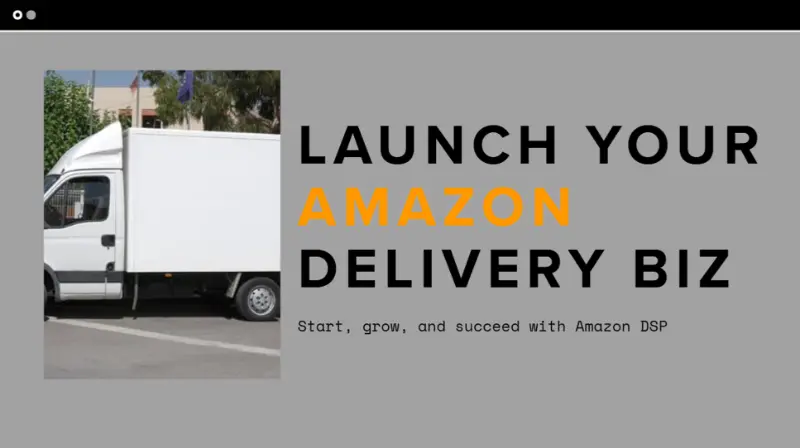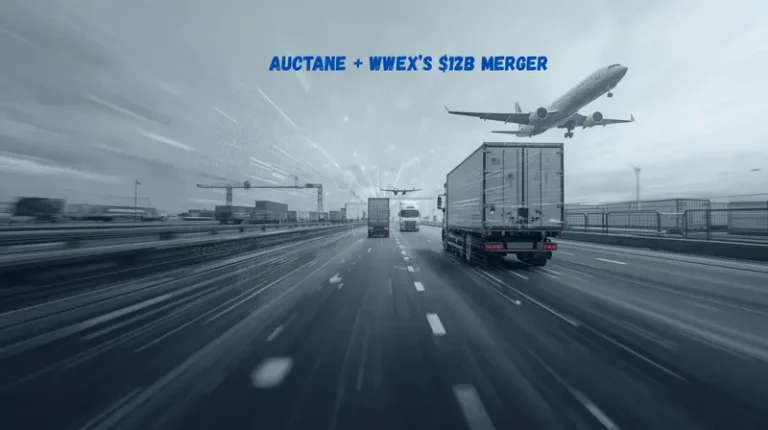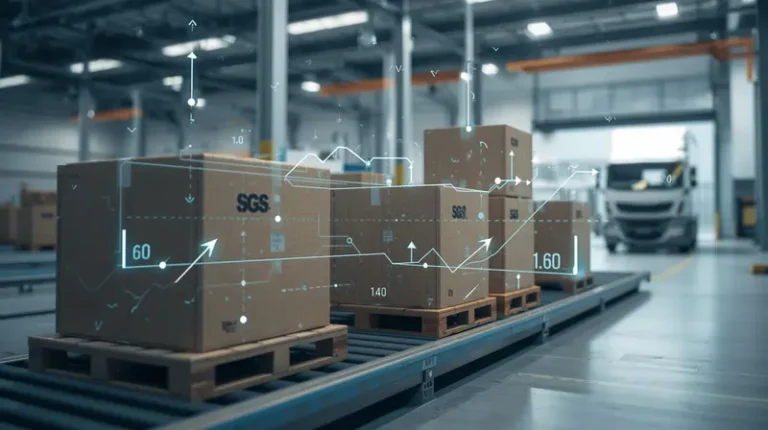Amazon DSP Program Success: How to Start and Grow Your Delivery Business

Last updated on August 21, 2025

In this article
 12 minutes
12 minutes
- The Appeal of Running Your Own Amazon Delivery Business
- Getting Started: Costs, Requirements, and Application Process
- What Amazon Provides: Support and Tools for DSP Owners
- The Reality Check: Day-to-Day Operations and Challenges
- Tips for Success as a DSP Owner
- Conclusion: Is the Amazon DSP Path Right for You?
- Frequently Asked Questions
The Appeal of Running Your Own Amazon Delivery Business
I remember when I first heard about the Amazon DSP program (Delivery Service Partner program). The idea was instantly intriguing: start your own delivery business, deliver Amazon packages, and get Amazon’s backing in terms of volume and support. For aspiring entrepreneurs, especially those eyeing the logistics industry, it sounded almost too good to be true. You get to tap into Amazon’s vast shipping demand and logistics tools, but still effectively run your own business. No need to build a customer base from scratch; Amazon is your customer, feeding you packages to deliver. Over 4,400 small businesses have already signed up as DSPs since the program launched in 2018, creating 390,000 driving jobs and generating $58 billion in revenue collectively. Those numbers are huge, and they show Amazon’s delivery network isn’t just UPS trucks and USPS mailmen; it’s thousands of independent owners like us driving the blue Prime vans around town.
Amazon continues to disrupt every sector it touches, and last-mile delivery is no exception. By recruiting small business owners to operate delivery fleets, Amazon has quickly built a logistics operation that rivals UPS and FedEx in parcel volume. (In fact, as of 2024, Amazon was delivering roughly 28% of all US parcels, surpassing FedEx and UPS by volume!) They’ve essentially crowdsourced their own private UPS, and as a result, people like you and me have an opportunity to own a delivery business without needing to court customers or create demand. Amazon provides a giant built-in market.
But let’s cut to the chase: What does it actually take to become an Amazon DSP and run a package delivery business? What are the costs, the requirements, the day-to-day realities? Is it true you can start with as little as $10,000 and make a good profit, as Amazon’s marketing suggests? I’ve done the research and even spoken to a few DSP owners. Here’s what I’ve learned about launching and growing a delivery company under the Amazon DSP umbrella.
Slash Your Fulfillment Costs by Up to 30%
Cut shipping expenses by 30% and boost profit with Cahoot's AI-optimized fulfillment services and modern tech —no overheads and no humans required!
I'm Interested in Saving Time and MoneyGetting Started: Costs, Requirements, and Application Process
One of the biggest draws of Amazon’s Delivery Service Partner program is the relatively low startup costs compared to, say, buying a franchise or starting a logistics company from scratch. Amazon advertises that you can start with as little as $10,000 in initial investment. That number is real, but it’s important to understand what it covers. Essentially, Amazon has negotiated deals on things like van leases, insurance, fuel, and uniforms. By taking advantage of those discounts, your upfront outlay to get, for example, 5 vans on the road can be around $10K. (In contrast, starting an independent delivery biz with 5 vehicles could easily cost several times that once you factor in buying/financing vehicles, etc.)
However, you also need to show you have enough liquid assets to sustain the business as it ramps up. Amazon requires proof of around $30,000 in liquid assets available. This is essentially a financial cushion; you might not spend all that, but Amazon wants to ensure you can pay your drivers and other expenses while cash flow builds. It’s a bit like proving you have some savings to handle the first few months of operation. They’ll do a financial assessment as part of the application.
Speaking of the application, Amazon’s process is quite involved (as it should be, since they’re trusting you with their reputation and packages). Here are the key steps and requirements:
- Background and Experience: You’ll need to submit a thorough application, including your work history, education, and any military service. Leadership experience is a big plus; Amazon is looking for people who can coach and motivate a team, handle scheduling, and problem-solve on the fly. Interestingly, logistics experience specifically is not required. Many DSP owners come from totally unrelated fields (banking, hospitality, etc.). But you do need a track record of leading teams or running projects; they want to see that you can manage 40 – 100 employees as your delivery team grows.
- Clean Background and Good Credit: There will be background checks and likely credit checks. Since you’ll be hiring drivers who handle packages, any red flags (e.g., serious criminal history) can disqualify you. Financial responsibility is also key because you’ll be handling payroll and expenses.
- Initial Screening and Interview: After the online application and assessments, promising candidates are invited to an interview. They want to gauge your understanding of the program and commitment. If selected, you don’t immediately get a delivery territory; you get placed into their pool to match with a delivery station location in need of new DSPs. You can express location preferences, but you may have to be flexible or wait for an opening.
- Training: Once accepted, Amazon provides two weeks of hands-on training. This includes a week at Amazon HQ or a regional facility learning the business side, and another week shadowing an existing DSP at a delivery station to learn the ropes. They cover everything from using their route optimization software to managing drivers. Amazon really emphasizes safety and process adherence in this training.
- Business Setup: You’ll establish your company (if you haven’t already), get any necessary licenses, and set up things like a commercial driver hiring pipeline, etc. Amazon assists in some of these areas. For example, they have recruiting tools to help you hire drivers and can even refer candidates. They want you to hit the ground running.
It’s worth noting Amazon also had (as of a couple of years ago) a Diversity Grant initiative: a $1 million fund that offered $10,000 for Black, Latinx, and Native American entrepreneurs towards startup costs. This was their effort to reduce barriers for underrepresented business owners. There was a bit of legal controversy around it (some non-minority applicants challenged it), but Amazon was pushing it as part of diversifying the DSP network. If you qualify, it’s something to look into; essentially, it could cover that initial $10K investment for you.
What Amazon Provides: Support and Tools for DSP Owners
Signing on as a DSP, you’re not buying a traditional franchise, but Amazon does act sort of like a franchisor in terms of setting standards and providing a playbook. Here’s what Amazon brings to the table for Delivery Service Partners:
- A Steady Volume of Packages: This is arguably the biggest perk. Amazon is your client, and they have more packages than they know what to do with. They’ll assign you routes each day for deliveries in your area. You don’t have to go find customers or drum up business; Amazon is essentially guaranteeing demand. If anything, the challenge is hiring enough drivers to handle all the demand, especially during Peak season (holidays).
- Logistics Technology: Amazon equips DSPs with its delivery management tech. This includes the route optimization software (the drivers use an app that maps out their route in the most efficient way, and it’s dynamically updated), scanning devices, GPS trackers in vans, etc. They also give DSP owners access to a central portal that shows all their routes, packages, performance metrics (delivery times, success rates, etc.), basically your business dashboard. It’s a turnkey tech platform many small businesses could never afford to develop on their own. Amazon’s logistics tools are best-in-class, and you get them by default as part of the program.
- Deals on Vehicles and Equipment: Instead of you having to buy vans outright, Amazon has negotiated vehicle lease programs. You lease Amazon-branded vans (the blue Prime vans) at favorable rates. Maintenance is included in many cases. They’ve also arranged bulk pricing on things like the handheld devices drivers use, uniforms, insurance, fuel, and even things like route planning software subscriptions if needed. These special rates on start-up equipment, devices, and insurance help reduce ongoing costs.
- Training and Ongoing Support: As mentioned, initial training is provided. But it doesn’t stop there. They have account managers or business coaches who will check in on your performance and help you succeed. There’s also a built-in support line, sort of like DSP support, for when issues arise (for example, if a van breaks down or you have routing problems, you have an on-demand support hotline). Amazon provides standardized processes for everything, which is helpful when you’re new. They even give you a DSP Toolkit with guides on HR, recruiting, scheduling, and “best practices” from their highest-performing DSPs.
- Payments and Incentives: Amazon pays DSPs per route/stop, etc., based on a contract rate. They also have performance-based incentives. For instance, if you hit certain delivery success metrics or safety milestones, you can earn bonuses or higher payouts. Amazon recently invested an additional $2.1 billion in rate increases and program enhancements to help DSPs with higher wages and vehicle costs. They know that if DSPs aren’t profitable, the whole program fails, so they adjust pay periodically (like a fuel subsidy when gas prices spike, or higher per-package rates in competitive labor markets).
In short, Amazon sets you up with the infrastructure: you have the vans, packages, software, and a playbook. Your job is essentially to hire and manage a team of reliable delivery drivers (called Delivery Associates or DAs) and execute the deliveries efficiently while meeting Amazon’s performance standards.
Looking for a New 3PL? Start with this Free RFP Template
Cut weeks off your selection process. Avoid pitfalls. Get the only 3PL RFP checklist built for ecommerce brands, absolutely free.
Get My Free 3PL RFPThe Reality Check: Day-to-Day Operations and Challenges
Running an Amazon DSP business is not an absentee-owner situation. Amazon expects hands-on owners who are deeply involved in day-to-day operations, especially at the start. Many successful DSP owners I’ve spoken with basically lived and breathed the operation in the early months: sorting packages at 6 am, dispatching vans, riding along on routes to learn the ropes, etc. Here’s a taste of the day-to-day and the challenges that come with it:
- Early Mornings and Route Planning: A typical day might start before dawn at the delivery station. Amazon staff will have sorted packages for your routes, but you (and maybe a hired dispatcher) will oversee loading. Each morning, you ensure each driver has their truck loaded with the right bags of packages, their device is working, and they understand their route. This can be a hectic phase; if someone calls in sick last minute, you might jump in to deliver or reassign routes on the fly.
- Managing Drivers: Expect to hire 40 – 100 delivery associates as you grow (a lot of routes run 7 days a week, so you have multiple shifts). Hiring and retention can be some of the toughest parts. The delivery driver role is physically demanding, with lots of walking, carrying boxes, driving all day, and turnover can be high. Some DSP owners report annual turnover rates north of 100% among drivers, meaning you might be constantly recruiting. One anecdote: a DSP owner mentioned they went through 150 – 200 drivers in a year due to turnover. Keeping drivers motivated and maintaining a good culture is crucial. Amazon monitors things like how fast and safely drivers are delivering, so you need to train and emphasize safety (no running to doors, even if you’re behind schedule, etc.).
- Performance Metrics (aka The Scorecard): Amazon tracks your business metrics closely; this is often referred to as your DSP scorecard. Key metrics include your delivery success rate (packages delivered on time without issues), driver safety incidents, complaints, and things like route completion rates. For example, they have targets for on-time delivery rate and valid tracking rate (you must scan every package) that you must meet. Also, keeping a low missed delivery rate and low customer complaints (those “this package was handled poorly” feedback) is important. If your metrics slip, Amazon can issue warnings, require action plans, or, in extreme cases, terminate your DSP contract. So, there’s pressure to perform consistently. It’s not just about finishing the day’s routes; it’s about doing so at a high service level.
- Long Hours and Problem Solving: As an owner, you’ll find yourself tackling unexpected problems. A van gets a flat tire. Who goes to help? (Often, you will, or you have a contingency van ready.) A driver can’t deliver a package because of a gated apartment complex. How can you train them for next time? Inclement weather, holiday volume spikes, and tech glitches with the routing app, a DSP owner has to be a chief firefighter of all such issues. During the Peak holiday season, expect to practically live at the station. It’s not uncommon to work 10-12-hour days during busy periods. Many owners do get to a point where they can delegate day-to-day to a station manager they hire, but initially, expect to hustle.
- Narrow Margins: Amazon sets the delivery rates, and while they aim to make it profitable, your margins per package can be slim after you pay driver wages, fuel, vehicle leases, insurance, etc. Efficient routing and keeping overtime low are key to making money. Some DSP owners mention that profit can be around $75K – $300K annually once scaled up, but results vary widely. If you’re in an area with higher labor costs or if you run into a lot of vehicle damage, it cuts into profit. Conversely, if you operate super efficiently (low turnover, minimal accidents, high stop count per route), you can do well. But this isn’t a get-rich-quick gig; it’s a medium-sized business with real expenses. (I always tell folks: don’t quit your day job expecting to clear six figures in Year 1; build up your operation first.)
- Autonomy vs. Rules: It’s “your” business, but Amazon sets many rules. You have to follow Amazon’s protocols for delivery (from how drivers buckle packages in their vans to how they ring a customer’s doorbell). They also dictate branding, your vans carry Amazon Prime logos, and drivers wear Amazon uniforms. You can implement your own culture and perks for employees, but the overarching guidelines are Amazon’s. Some entrepreneurs chafe at this because you are somewhat limited in making independent decisions (for instance, you can’t decide to deliver for other companies on the side; your contract typically ties you to Amazon packages only). Think of it as being an independent contractor in a very structured system.
All that said, many DSP owners find the work rewarding. A common sentiment: “It’s incredibly challenging, but I love being able to grow something and provide jobs.” For example, a DSP owner named Carlecia (featured on Amazon’s blog) started in 2022 and now employs 120 people across two stations. She talks about the pride of providing livelihoods and giving back to her community through the program. So, there’s a real opportunity to have a positive impact locally while riding on Amazon’s logistics might.
Tips for Success as a DSP Owner
If you’re serious about taking on an Amazon delivery business opportunity, here are some strategies and insights gleaned from those who have done it:
1. Hire Smart, Train Hard: Your drivers are your business. Prioritize hiring people who are reliable and customer-friendly. Use Amazon’s recruiting support, but also get creative, tap local job fairs, refer-a-friend bonuses for your current drivers, etc. Once hired, train them thoroughly on the routes, the scanner device, and Amazon’s expectations (like on-time delivery standards and safety reminders such as not backing up unnecessarily, wearing seatbelts, dog bite prevention, etc.). Well-trained drivers will be more efficient and make fewer mistakes (which keeps your Amazon scorecard healthy).
2. Create a Positive Team Culture: Delivery work is tough. Little things can keep morale up, providing water and snacks for drivers, recognizing top performers, and celebrating hitting milestones (like 100% delivery day or safety streaks). Some DSPs do morning huddles with a quick motivational talk or shout-outs. If you treat drivers as valued team members rather than package-hauling machines, you’ll reduce turnover. Also, be open to their feedback; the folks on the road often have ideas to improve routing or efficiency.
3. Keep an Eye on Efficiency Metrics: Use Amazon’s provided dashboards to monitor your performance goals daily. Watch your route completion times, package consolidation (are vans leaving with under-loaded capacity?), and any “failed delivery” reasons. By analyzing this data, you can spot trends, for example, if one route or driver consistently runs behind, maybe the route is too large or there’s a traffic issue you can reroute around. Small tweaks can save you overtime costs and improve your stops per hour. Amazon loves efficiency, and higher productivity can sometimes lead to Amazon offering you more routes (more routes = more revenue).
4. Safety First (It Pays Off): Amazon is pretty strict about safety, for good reason. Accidents or injuries are bad for everyone. Enforce the safety training points: drivers should take breaks, avoid rushing, and follow all protocols (like using a delivery cart for heavy packages, dog awareness, etc.). Not only will this avoid the nightmare of someone getting hurt, but Amazon’s incentives often reward safe operations. For instance, keeping a low accident rate and high compliance might qualify you for quarterly bonuses or better route assignments. Some DSPs even incorporate a daily quick safety tip in their morning meet-ups to keep it top of mind.
5. Plan for Peak Season Early: The November-December surge (and to a lesser extent, Prime Day or other big sales) will push your operation to its limits. Plan ahead, start recruiting seasonal drivers by late summer, secure extra vans if possible, and maybe have administrative staff or yourself ready to jump in on delivery routes when volume peaks. It’s common for DSP owners to deliver packages themselves during Peak to handle overflow. If you plan well and communicate expectations to your team (yes, there will be long days, yes, everyone works most days in December), you can get through it and even enjoy the challenge. Amazon often pays extra incentives during Peak due to the intensity, so a well-run Peak can significantly boost your annual profit.
6. Network with Other DSPs: Amazon hosts an online forum and occasional meet-ups for DSP owners. Use these to your advantage. Other DSPs aren’t your direct competitors (they operate in their own territories), and they can be gold mines for advice. They’ll share tips on everything from which route optimization tricks work best to how to handle a driver who consistently calls out. I’ve seen DSP owners help each other by loaning vans in a pinch or covering routes if one had a crisis. Being part of the community also keeps you in the loop if Amazon updates policies or makes changes to the program.
Running an Amazon DSP can definitely become a thriving small business if managed well. Amazon’s VP of delivery operations often says they want DSP owners who are “obsessed with customer experience and their people.” That seems to ring true: focus on reliably getting packages to customers on time (making Amazon look good) and focus on keeping your employees happy. That formula, backed by Amazon’s demand and resources, is a path to success in the program.
Scale Faster with the World’s First Peer-to-Peer Fulfillment Network
Tap into a nationwide network of high-performance partner warehouses — expand capacity, cut shipping costs, and reach customers 1–2 days faster.
Explore Fulfillment NetworkConclusion: Is the Amazon DSP Path Right for You?
The Amazon delivery service partner program is an innovative model: Amazon leverages local entrepreneurs to expand its delivery reach, and those entrepreneurs get a shot at business ownership in a booming sector. It’s not a guaranteed money-printing machine (anyone who thinks they’ll just hire a manager and sit back should think again). It requires hustle, resilience, and adaptability. You’re dealing with humans (drivers, customers) and a tech giant’s systems, both can be unpredictable at times! But if you put in the effort, you can build a solid operation with stable revenue.
To sum it up, the DSP program offers a relatively accessible way to own a delivery business for those who have leadership chops and a willingness to work within Amazon’s framework. You don’t need to be a logistics expert or come with a fleet of trucks; Amazon provides the playbook and the packages. Your job is to execute with excellence. Many small business owners have used this program to become employers in their community, create hundreds of jobs, and yes, make a good living in the process. They’ve shown that with grit and smart management, you can successfully run an Amazon delivery business.
Like any business, there are risks: thin margins, high turnover, and the fact that Amazon can change the rules or pricing (their recent changes to the contract rates and the end of the de minimis shipping exemption show the environment can shift). However, Amazon has a vested interest in DSPs succeeding; they need you to deliver their packages. As Amazon keeps growing its ecommerce dominance, the volume of packages isn’t slowing down; if anything, there’s more demand for delivery routes every year. That bodes well for DSPs who run efficient operations.
In the end, whether the DSP program is right for you comes down to your personal goals and management style. If you enjoy hands-on operations, don’t mind rolling up your sleeves (or driving the occasional van yourself), and get satisfaction from meeting targets and growing a team, it could be a great fit. It’s a chance to ride on Amazon’s growth while still being your own boss day-to-day. Just go in with eyes open, realistic expectations, and a strong work ethic. Starting a delivery business through Amazon isn’t easy money, but for many, it’s proving to be good money and a pretty exciting ride in the process.
Frequently Asked Questions
How do I become an Amazon Delivery Service Partner?
Apply through the Amazon DSP program site, show $30K in liquid assets, pass background checks, complete training, and launch with Amazon-provided routes and vans.
How much does it cost to start a DSP business?
Startup costs begin at around $10K with Amazon-negotiated discounts. You’ll also need $30K in liquid assets to cover wages, fuel, and early operating expenses.
Can I make a profit as a DSP owner?
Yes. Profits for scaled DSPs typically range from $75K to $300K annually, depending on fleet size, route efficiency, and meeting Amazon’s performance metrics.
What’s the difference between Amazon DSP and Flex?
DSP is running a delivery business with employees and Amazon vans. Flex is gig work, where drivers use their own cars for smaller deliveries and work as independent contractors.
What support does Amazon provide DSP owners?
Amazon offers training, coaching, routing software, performance dashboards, discounts on vans and insurance, guaranteed package volume, and 24/7 operational support.

Turn Returns Into New Revenue





